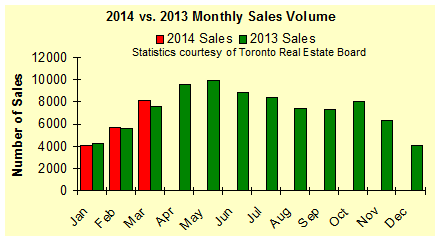Toronto Income Property Newsletter:
April 2015
Spring is here. A lot of new houses hit the market in downtown Toronto last week. It often happens after March break that a lot of new inventory surfaces. There were not a lot of income properties for sale in this first quarter of 2015, so it is nice to see more plexes coming online. These new listings ought to eat up some of the pent-up demand that we have been experiencing, although I still think that it will be a Sellers’ market for the foreseeable future.
I’d like to wish all of you and your families a very Happy Easter. Also, a friendly reminder to check out the newly designed Plex website if you haven’t done so already – we have a couple of great income properties for sale at the moment that you may want to have a look at. Please do have a look at the Toronto Income Property Guide- my new book about buying, selling and managing investment properties.
– P.A.
[hr]
Toronto Detached Homes Average over $1,000,000
It was reported last month that for the first time, the average selling price of a Toronto (416 area code) detached home has pushed above $1 million. The Toronto Real Estate Board says the 416 average detached price rose 8.9 percent year-over-year to hit $1.04 million in February. In the 905, the average is closer to $700K. Supply is tight when it comes to detached homes in this city, and demand is still very high. Sales are up some 17 percent year over year. It is not only detached homes that have seen these percentage increases. Semis and townhomes are up as well. I believe that since there were fewer listings than normal in the first few months this year, this has helped keep the prices this high. Toronto has now become like Vancouver and other leading world class cities insofar as prices for detached homes.
My feeling is that with prices this high, there are likely going to be a lot of new home-owners in debt for a long time. I think a lot of younger home buyers are being bank-rolled by their parents and they are able to take advantage of historically low interest rates. Some experts may feel that a decline or “crash” is coming, but I’m not so sure about that. The population has been steadily increasing. Also, it is quite easy for foreigners to come into Toronto to buy real estate which I believe has fueled a lot of the growth – especially in condo-land.
[hr]
Spring Cleaning Checklist
This is the time of year when landlords should look after a few maintenance items at their income properties. After a long cold winter, it is prudent for landlords to take advantage of the warmer weather to make sure their investment property is in tip-top shape. Here is a list of ten maintenance items that I recommend you, as a landlord, should consider:
– Check your eavestrough for any areas that are plugged with debris from the long winter. Look for any places that are cracked and leaking. Also, make sure that downspouts are properly draining away from the house. Poor drainage can lead to a weakened foundation and even flooding in basement areas. The City of Toronto does not allow for you to drain back into the house, but rather expects your drain to run away from the property.
– Look at your roof shingles from the safety of the ground. Inspect the roof as best you can to see if any were lost during the winter. If you notice any shingles that are cracked, loose, or missing, make arrangements to have them fixed or replaced. While a roofer is up there, have them check the flashing around the vents and look for puddles if your roof or a portion of it is flat.
– Examine any outdoor hose faucets for winter damage by turning the water on and letting it run for a few minutes. If you aren’t getting much water, there could be damage to pipes inside.
– Inspect any wood, wood trim, shutters and so forth on the exterior of the rental property to see if there is any wood rot. Warmer temperatures and spring rain can make a small problem a lot worse, so get it fixed before that happens. In Toronto, we have termites in certain areas of the city and they tend to like moist wood.
– Check sidewalks and the driveway for any new cracks or sinking. The moisture and cold weather from winter can cause concrete to crack, heave or sink.
– Check on the condition of the property’s fences and see to any repairs as needed. If the fence is vinyl or wood and sustained any damage during the winter, it should get fixed sooner rather than later. Remember good fences make good neighbours.
– Trim trees, shrubs and plants as may be needed. It’s also an ideal time to plant any new items like a tree or bush to improve the curb appeal of the rental property. Add mulch to flower beds if needed.
– Wash the siding of the rental property using a power washer or the old-fashioned bucket and sponge. Not only will it look better, but you’ll get an up-close look at the property, the foundation, the flower beds and more to possibly discover other issues or problems you or your tenants wouldn’t normally notice. You may want to consider power-washing your external brick as well.
– Give the exterior of the windows a good cleaning using a recommended window cleaning solution. Also, don’t forget to clean and repair the rental property’s window screens.




